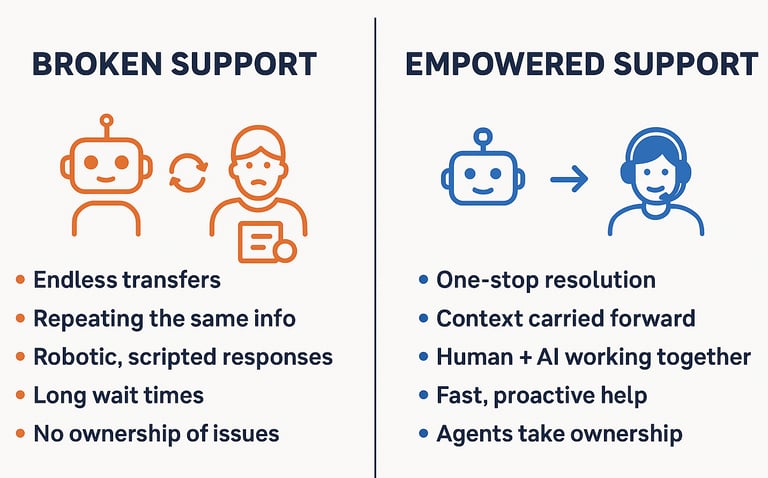Customer Support Is Broken: Why Bots and Scripts Are Letting Us Down
Mihir Joshi


Have you ever spent 20 minutes arguing with a bot just to get a human on the line? You try to explain your problem, but the bot doesn’t actually understand it - it just keeps throwing canned responses or irrelevant menu options back at you. And when you finally do reach a human, the relief is short-lived. Instead of solving your issue, they read from a script: “I’m sorry for the inconvenience.” “Thank you for your patience.” “Is there anything else I can do for you today?”
It’s polite, sure. But is it support? Not really.
The Problem With Customer Support Today
Customer support has shifted from being about solutions to being about systems. Companies are so focused on efficiency and automation that they’ve forgotten the core of customer care: actually helping people.
Here’s the typical experience:
Bots don’t have full information and can’t handle nuance.
Phone numbers to reach a human are hidden deep inside apps and websites.
When you finally get through, the associate has no power - just a script to read from and a form to log your complaint.
The result? Customers feel unheard, stuck, and frustrated.
My Experiences with Customer Support
Recently, I had a medicine delivery delayed - a situation where time really mattered. So I called support.
The associate was polite, professional, and genuinely empathetic. I could tell he wanted to help. But when I asked if he could expedite the order, he couldn’t. His hands were tied by the process. He kept returning to the script, apologizing, and noting down my case.
It wasn’t his fault. The intent to help was there. The power wasn’t. And that’s the bigger issue with customer support today.
To be fair, some companies are getting it right. Amazon’s customer support (at least in India) feels different:
Their bot handles the basics well: refunds, replacements, order status.
On the rare occasion I need a human, the associate doesn’t just log a complaint - they act. They can authorize a refund, fast-track a replacement, or override the system when it makes sense.
That’s the difference: trust and empowerment. The system trusts the associate to do their job, and as a customer, I feel like someone is actually taking ownership of my problem.
What Needs to Change
So what would make customer support better? A few key shifts:
Smarter Bots, Not Stubborn Bots: Bots should know their limits and escalate quickly when the issue is beyond them.
Empowered Associates: Human agents should have the authority to make exceptions, issue refunds, or fast-track cases.
Focus on Resolution, Not Process: Customers don’t call to get a case number. They call to get their issue solved.
Technology as a Tool, Not a Barrier: Automation should remove friction, not empathy. It should support humans, not wall them off from customers.


GenAI and Agentic AI: Hope or Hype?
Many companies are now experimenting with Generative AI (GenAI) bots. They’re smarter than old rule-based systems, but they still fall short. They can mimic empathy, but often miss context, leaving customers with answers that sound right but don’t actually help.
The real promise lies in Agentic AI - systems that don’t just answer but act. Imagine a support bot that can reschedule a delivery, issue a partial refund, or escalate to the right associate with suggested actions. That’s where AI could truly transform support: by being outcome-driven, not just conversation-driven.
Final Thought
Customer support is the “moment of truth” for any company. It’s where loyalty is built, or broken. Right now, too many companies are breaking it with bots that don’t understand, systems that hide humans, and associates stuck to scripts with no real power.
At the end of the day, customers don’t remember the case ID you gave them. They remember whether you cared enough and were empowered enough to fix the problem.
Have you been stuck with bots, or found support that truly cared? Share your story in the comments
I’d love to hear how customer support has worked (or failed) for you.
Author Info
Written by Mihir Joshi
After 15 years working with leading manufacturers, I created SmartServiceOps to share practical insights for the field service industry.
